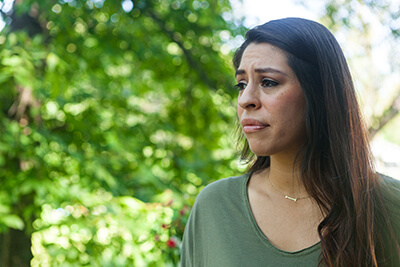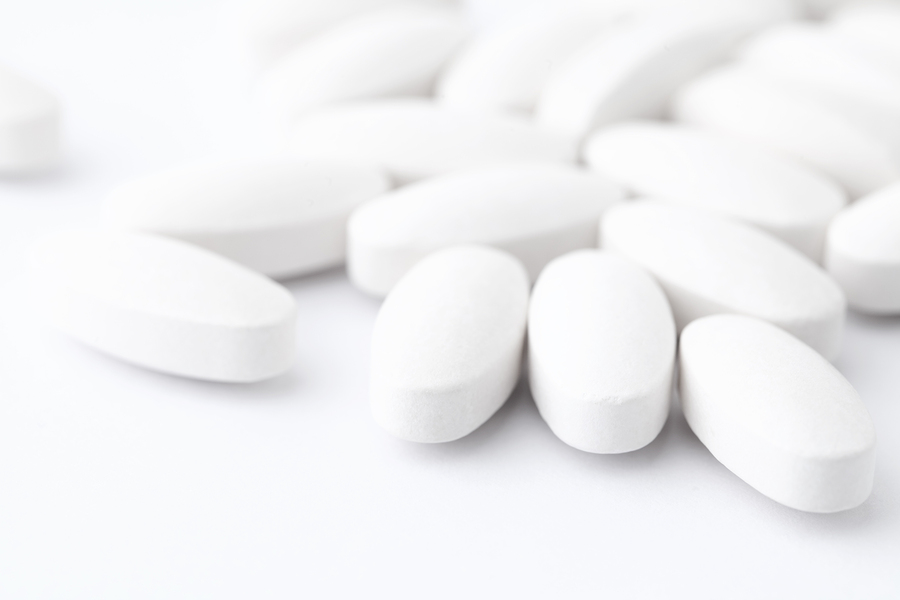 When someone experiences sudden, uncontrollable, and overwhelming amounts of fear for no explicable or rational reason, it may be a panic attack. A panic attack generally lasts about 10 minutes, although sometimes it can last longer. It may include both emotional and physical reactions including intense anxiety, fear, loss of touch with reality, trouble breathing, feelings of being smothered, disorientation, feeling faint, dizziness, rapid heart rate, sweating, hot or cold flashes, stomach discomfort, chest pain, or a tingling or numbness in the hands. The brain sends signals to the body to institute the fight-or-flight reaction when someone feels scared or threatened, which may be triggered unnecessarily in a panic attack.
When someone experiences sudden, uncontrollable, and overwhelming amounts of fear for no explicable or rational reason, it may be a panic attack. A panic attack generally lasts about 10 minutes, although sometimes it can last longer. It may include both emotional and physical reactions including intense anxiety, fear, loss of touch with reality, trouble breathing, feelings of being smothered, disorientation, feeling faint, dizziness, rapid heart rate, sweating, hot or cold flashes, stomach discomfort, chest pain, or a tingling or numbness in the hands. The brain sends signals to the body to institute the fight-or-flight reaction when someone feels scared or threatened, which may be triggered unnecessarily in a panic attack.
Sometimes a panic attack may be an isolated event; however, in other instances, panic attacks may be recurrent, occur without warning, and be a symptom of a mental health disorder, such as panic disorder. About 6 million Americans are diagnosed with panic disorder, an anxiety disorder that affects double the number of women than men, and generally appears in early adulthood or during the late teenage years, the National Institute of Mental Health (NIMH) reports. An individual suffering from panic disorder worries excessively about the next attack that may create a loss of control, potentially causing them to avoid places, things, or people that may have been related to a previous panic attack.
Risk Factors for a Panic Disorder
Scientists are not clear on what exactly may cause panic disorder, although it may involve genetic, biological, and environmental aspects. The National Alliance on Mental Illness (NAMI) publishes that a panic attack may be caused by a variety of factors, including:
- Stress or anxiety
- Lack of sleep
- Hormonal or chemical imbalance
- A traumatic event
- Mental illness
- Drug or alcohol abuse
When panic attacks cause anxiety, worry, and fear that interfere with everyday life, and cause social, emotional, occupational, and interpersonal problems, they may result in a diagnosis of panic disorder. Psych Central reports that out of all of the anxiety disorders, people most commonly seek medical attention for panic disorder.
The areas of the brain involved in the fear and stress response may be dysfunctional in a person who develops panic disorder and the nerve firings may be overactive. This may cause someone to form unhealthy coping mechanisms in order to avoid bringing on a panic attack.
About a third of the individuals diagnosed with panic disorder will develop a phobia of open spaces and going outside, or leaving the house, alone without a trusted individual, which is known as agoraphobia, NIMH publishes. Other mental health disorders may co-occur with panic disorder at high rates as well. NAMI reports as many as half of those suffering from panic disorder will also develop depression, perhaps as the result of the panic disorder.
Substance Abuse as Medication for Panic Disorder Symptoms
 According to the Primary Care Companion to the Journal of Clinical Psychiatry, about 20 percent of the individuals diagnosed with panic disorder may also suffer from an alcohol or drug dependence at some time in their lives. As reported in the journal Psychiatric Times, about 3.5 percent of individuals studied who were diagnosed with panic disorder and comorbid agoraphobia also had a co-occurring alcohol use disorder (AUD), while 9.2 percent suffered from a simultaneous drug use disorder. The percentages were slightly lower (2.9 percent for an AUD and 6.4 percent with a drug use disorder) for those diagnosed with panic disorder without comorbid agoraphobia.
According to the Primary Care Companion to the Journal of Clinical Psychiatry, about 20 percent of the individuals diagnosed with panic disorder may also suffer from an alcohol or drug dependence at some time in their lives. As reported in the journal Psychiatric Times, about 3.5 percent of individuals studied who were diagnosed with panic disorder and comorbid agoraphobia also had a co-occurring alcohol use disorder (AUD), while 9.2 percent suffered from a simultaneous drug use disorder. The percentages were slightly lower (2.9 percent for an AUD and 6.4 percent with a drug use disorder) for those diagnosed with panic disorder without comorbid agoraphobia.
Sedative drugs, such as benzodiazepines, alcohol, marijuana, and opioids like heroin and prescription painkillers, are all considered central nervous system depressants and help to block anxiety, fear, and the stress reaction, increasing relaxation and pleasurable feelings instead. These drugs may be abused at high rates by someone attempting to self-medicate symptoms of panic disorder. In the short-term, this may seem to work, as these substances may make users feel happy and mellow, increase self-esteem, and soothe the overactive nerve firings in the brain that cause anxiety and fear.
Brain chemistry is altered with repeated substance abuse, however, and the brain may no longer make some of its neurotransmitters responsible for feelings of pleasure at the same rates. Motivation, impulse control, mood regulation, and cognitive functions may be impaired.
When a person is dependent on drugs or alcohol, and the substance is removed, withdrawal symptoms may occur. This may cause a sort of rebound effect in the brain, and anxiety, fear, panic, and depression may return at even higher rates than before. As a result, panic disorder symptoms may be increased by alcohol or drug abuse in the long run. Chronic substance abuse and addiction therefore alter the way the brain functions and may impact several important regions in the brain related to decision-making, memory formation, emotional regulation, and stress management.
Treating Panic Disorder and Addiction
When someone suffers from panic disorder or an additional form of mental illness, and also battles drug or alcohol addiction concurrently, the disorders are said to be comorbid. Mental health and medical professionals work in tandem to devise a comprehensive treatment strategy that may involve the use of medications, therapy, and counseling for an integrated approach during treatment and recovery.
There are three main types of medications approved by the U.S. Food and Drug Administration (FDA) to treat panic disorder, as highlighted by Mayo Clinic. These are serotonin and norepinephrine reuptake inhibitors (SNRIs) and selective serotonin reuptake inhibitors (SSRIs) which are both antidepressants, and anti-anxiety benzodiazepine medications. Specific medications are as follows:
SNRI:
- Effexor XR (venlafaxine hydrochloride)
SSRIs:
- Prozac (fluoxetine)
- Paxil and Pexeva (paroxetine)
- Zoloft (sertraline)
Benzodiazepines:
- Xanax (alprazolam) a benzodiazepine
- Klonopin (clonazepam)
Antidepressants may take longer to begin working, while benzodiazepines, or benzos, typically act rather quickly on panic disorder and anxiety symptoms. Benzos can also be highly addictive, however, and they are not recommended to be taken for longer than a few weeks. They may not be ideal for an individual with a comorbid substance abuse disorder or history of substance abuse and/or addiction.
Other medications may not be specifically approved for the treatment of panic disorder, but have positive effects on specific symptoms. Beta blockers may reduce some of the physical discomfort, such as irregular heart rate, dizziness, or elevated body temperature, for example. Vitamins and supplements may also be prescribed by a doctor to increase a person’s overall physical and nutritional wellbeing, which may have been neglected due to addiction, mental illness, or both. Medications may also be used to reduce the side effects of alcohol or drug withdrawal during medical detox.
The American Psychological Association (APA) recommends that therapy techniques be the first line of care in treating panic disorder. Therapy is the primary method of treatment for addiction issues as well. Mental health professionals may use Cognitive Behavioral Therapy (CBT) to explore potential fear triggers and get to the root of what may cause someone panic attacks or lead to substance abuse. This therapy also helps to develop new and improved coping strategies and healthy stress management tools. Learning relaxation techniques and alternative forms of handling stressful situations can be helpful. In addition, support groups that can offer a sympathetic environment and network of peers may also be beneficial.
Exposure therapy in a safe and secure environment may help individuals learn how to face their fears by desensitizing them to potentially triggering places or events in a slow and nonconfrontational manner. Education, on what exactly panic disorder is, what causes it, how it relates to substance abuse and addiction, and how symptoms may be reduced and relapse prevented, can help individuals and families better understand the disorder. These therapeutic treatments can help individuals to effectively manage co-occurring panic disorder and addiction.
